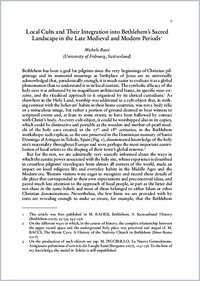Local Cults and their Integration into Bethlehem's Sacred Landscape in the Late Medieval and Modern Periods
BHAP-HA+SCANT
- Bacci, Michele Université de Fribourg
-
2020
Published in:
- Bethlehem. A Sociocultural History / Rāḥib, Mitrī. - Diyar Publishers. - 2020, p. 25-40
Terre Sainte (Palestine)
Dévotion
Arbres
Pèlerinages
Lieux sacrés
Bethlehem
Holy Land Pilgrimage
Sacred Landscapes
Kinetic Devotion
Trees
Hummus
Loca Sancta
English
The paper is a post-print version of an article originally published in Mitri Raheb (ed.), "Bethlehem. A Sociocultural History", Bethlehem: Diyar Publishers, 2020, p. 25-40, though without the illustrations presented here. It analyses the dynamics by which the kinetic dimension of pilgrimage contributed to invest the landscape associated with the way leading from Jerusalem to Bethlehem with new meanings and a number of secondary spots deemed to be associated with various episodes of Biblical history. The latter include the terebynth of Mary, the cistern of the Magi, the house of Prophet Habakkuk, the field of the stone chickpeas ("Jrun el-hummus"), Rachel's tombs and the cisterns of David. Their complex history is investigated relying on evidence provided by Late Medieval and early Modern travelogues.
- Faculty
- Faculté des lettres et des sciences humaines
- Department
- Département d'histoire de l'art et d'archéologie
- Language
-
- English
- Classification
- Art history
- License
-
License undefined
- Identifiers
-
- RERO DOC 330461
- Persistent URL
- https://folia.unifr.ch/unifr/documents/309373
Statistics
Document views: 274
File downloads:
- Texte intégral: 530
